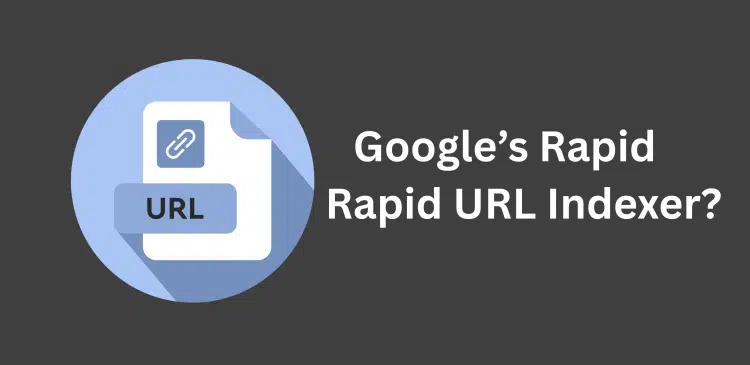What is Google’s Rapid URL Indexer?

Google employs various mechanisms and methods to access and index web pages, ensuring that content is visible and available in its search engine database. Among the various tools available, one that often flies under the radar is the Rapid URL Indexer. This article delves deeper into the concept of the Rapid URL Indexer, outlining its definition and the significant role it plays in improving Google’s indexing process.
What is Indexing?
To understand the Rapid URL Indexer, it’s essential to first clarify the concept of indexing. Indexing refers to the technique employed by Google to organize the necessary information for a search, ensuring that users receive swift search results. Indexing is the process of storing the information found on a page in Google’s database, making it easily accessible for users when they search.
The Importance of Indexing
- Indexing:For website and web pages to be returned in the results list they have to be indexed. If any web page is not indexed, it means that the page can never appear in the search results page of Google regardless if the content of the page is the most relevant and full of quality content.
- SEO:Indexing is one of the key aspects that all SEO plans and strategies must cover. As it impacts the position of the website in the list of search results, it is directly proportional to the amount of traffic the website garners.
- Ease of Use:Indexing makes it easier for the users to locate their desired information as quickly as possible.
The Role of Web Crawlers
- Content Location:One organic method of content location through Google is the spiders, also known as bots, which search the webs in an organized manner with the intention of finding new content.
- Indexing:Crawlers navigate through web pages, exploring all relevant links found on the pages they visit to discover additional content. This helps Google understand the connections between multiple pages and contributes to creating a well-organized overview of any website.
Transition to Indexing
After Google crawls and analyzes the pages, it processes and stores the gathered information in its index. In this context, the Rapid URL Indexer holds significant importance once more.
Introducing the Rapid URL Indexer
The Rapid URL Indexer is an element of Google’s indexing system and is designed specifically for such purpose. It is mostly expected to speed up the indexing of newly found or newly changed URLs.
How Does the Rapid URL Indexer Work?
- Relevance of Content: The Rapid URL Indexer is designed to function with newly created URLs or those that have undergone recent updates. This approach allows Google to share fresh content from these URLs with users promptly.
- Managing Priority URLs:URLs are crucial for several reasons, including how often they change, the popularity of the website, and any updates to the content. Moreover, it serves as a valuable resource for Google, facilitating the quick incorporation of these updates into its index via the Rapid URL Indexer.
- Speed and Efficiency:Another approach involves enhancing indexing by organizing specific URLs, which ultimately results in improved speed and efficiency. This approach enables Google to keep its index current and provide users with the latest information.
Benefits of the Rapid URL Indexer
- Frequency of updates:The next advantage goes to the websites that update their contents frequently, as their content is quickly relayed to the users via the Rapid URL Indexer.
- Benefits:Quickly collecting both new and updated materials may make the search results more relevant for the user.
- SEO Benefits:From an SEO perspective, the rapid indexing of a site’s content by search engines is a significant advantage that many websites owners leverage, as fresh content tends to attract more attention.
Best Practices for SEO with the Rapid URL Indexer
Drawing a clear understanding of what the Rapid URL Indexer will assist the owners of the websites, and SEO specialists to enhance the speed of their content indexing.
Creating Index-Friendly Content
- Updating:Updating the content of the website is crucial to prevent stagnation and ensure that the information remains relevant. This indicates to Google that your site is active, potentially leading to quicker indexing due to its relevance.
- Usability:Make sure the website’s structure is properly established and that internal links are utilized as intended. This helps Google bots navigate your site effortlessly, making the indexing process smoother.
- Conveys Business Value:To ensure optimal visibility, the content must incorporate relevant terms that align with what users are searching for regarding the business. This helps with SEO and signals to Google that your published content is valuable and should be indexed quickly.
Utilizing Sitemaps
- XML Sitemaps:Submit an XML sitemap to Google Search Console. This allows Google to have a framework of your website in order to easily locate and index new content.
- Dynamic Sitemaps:If your website features frequently updated data, it’s advisable to opt for dynamic site maps. This highlights how Google remains vigilant to any shifts occurring in its immediate surroundings.
Monitoring Indexing Status
- Google Search Console: Similarly, Google Search Console serves as a tool to check the indexing status of your pages. Moreover, it provides insights into how the search engine views your website and identifies any indexing issues that may exist.
- Index Coverage Report:The indexing report in Google Search Console is crucial as it reveals which pages of your site have been indexed, highlights any issues that may have arisen, and provides guidance on how to address them.
